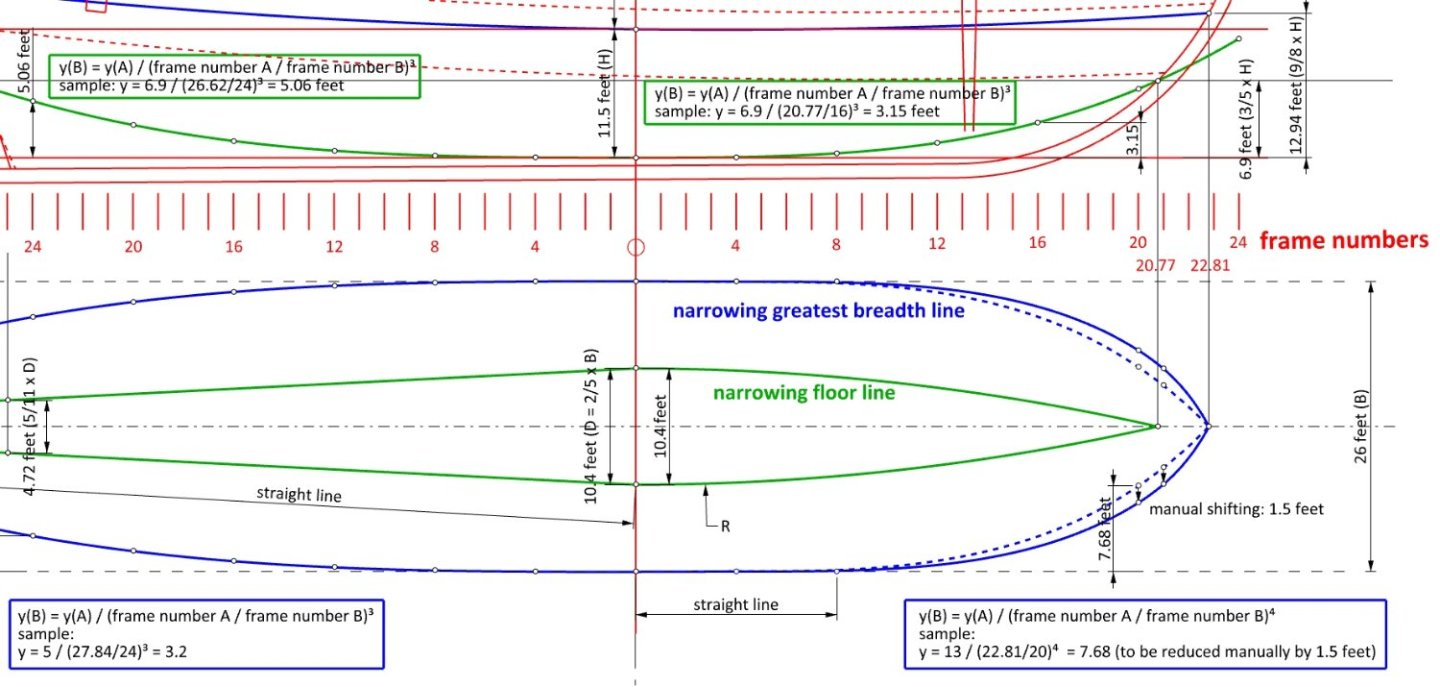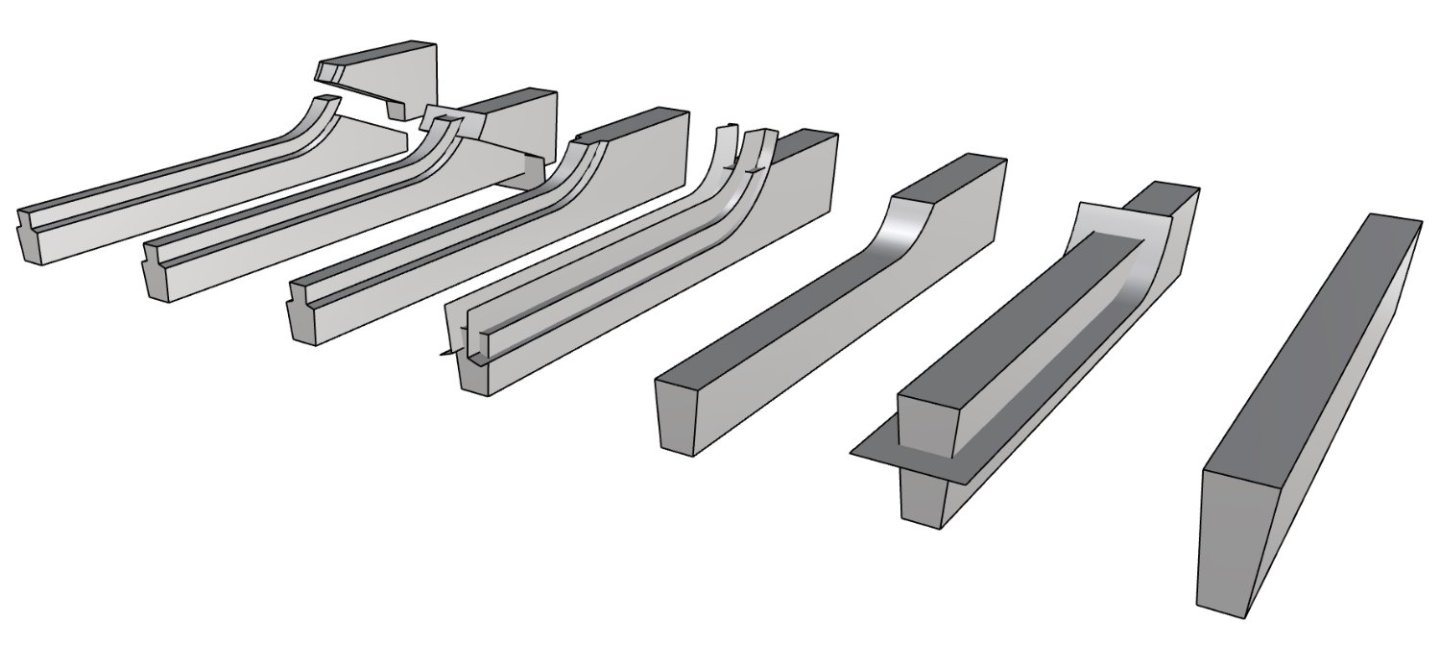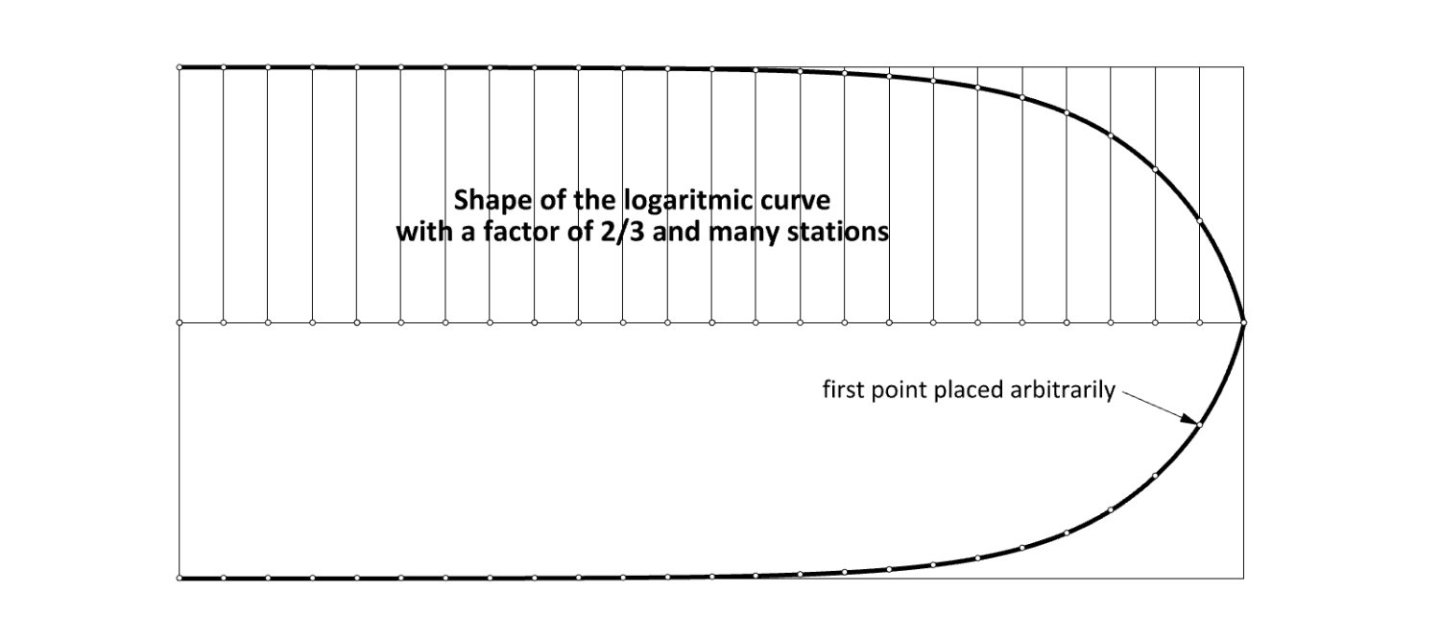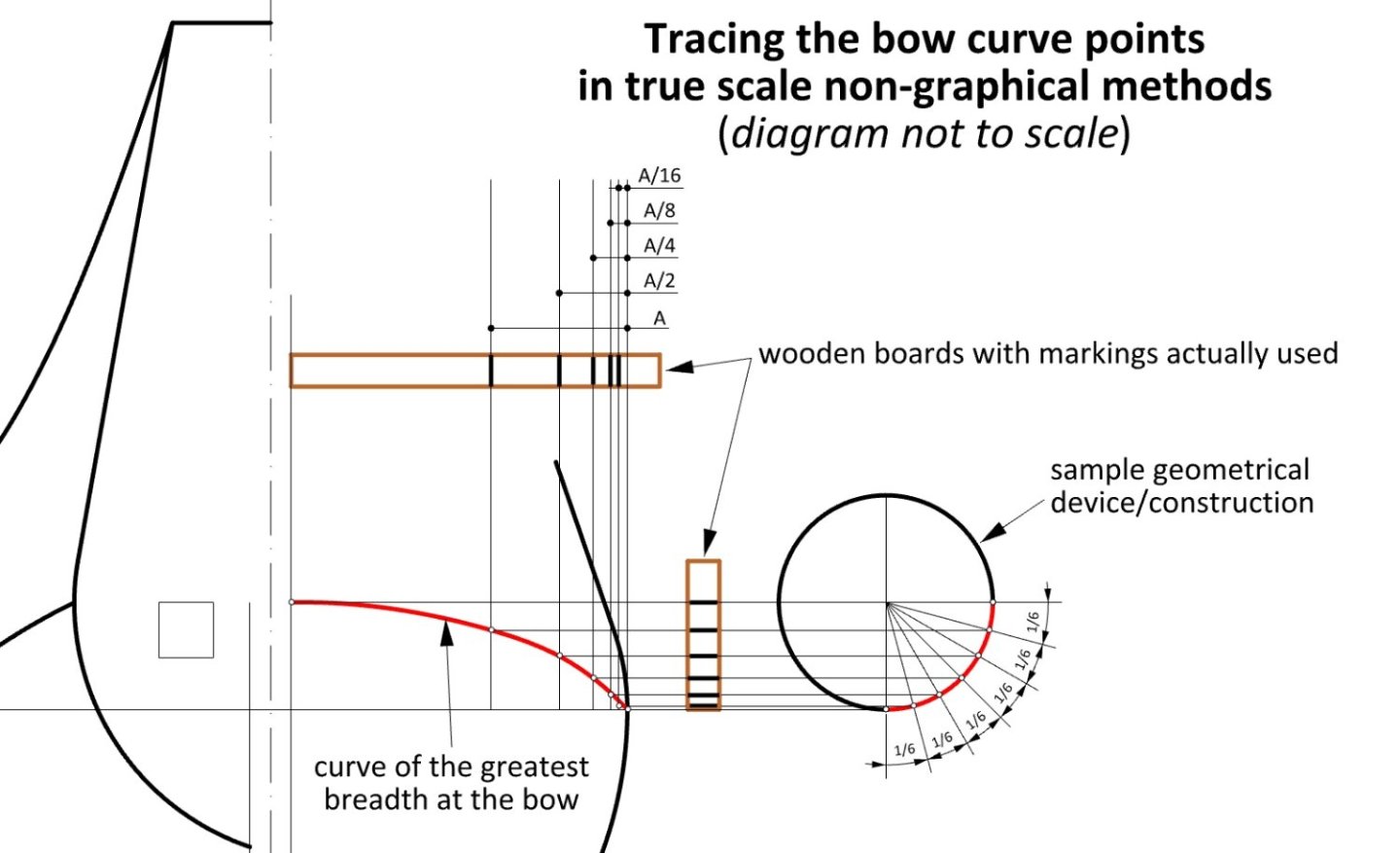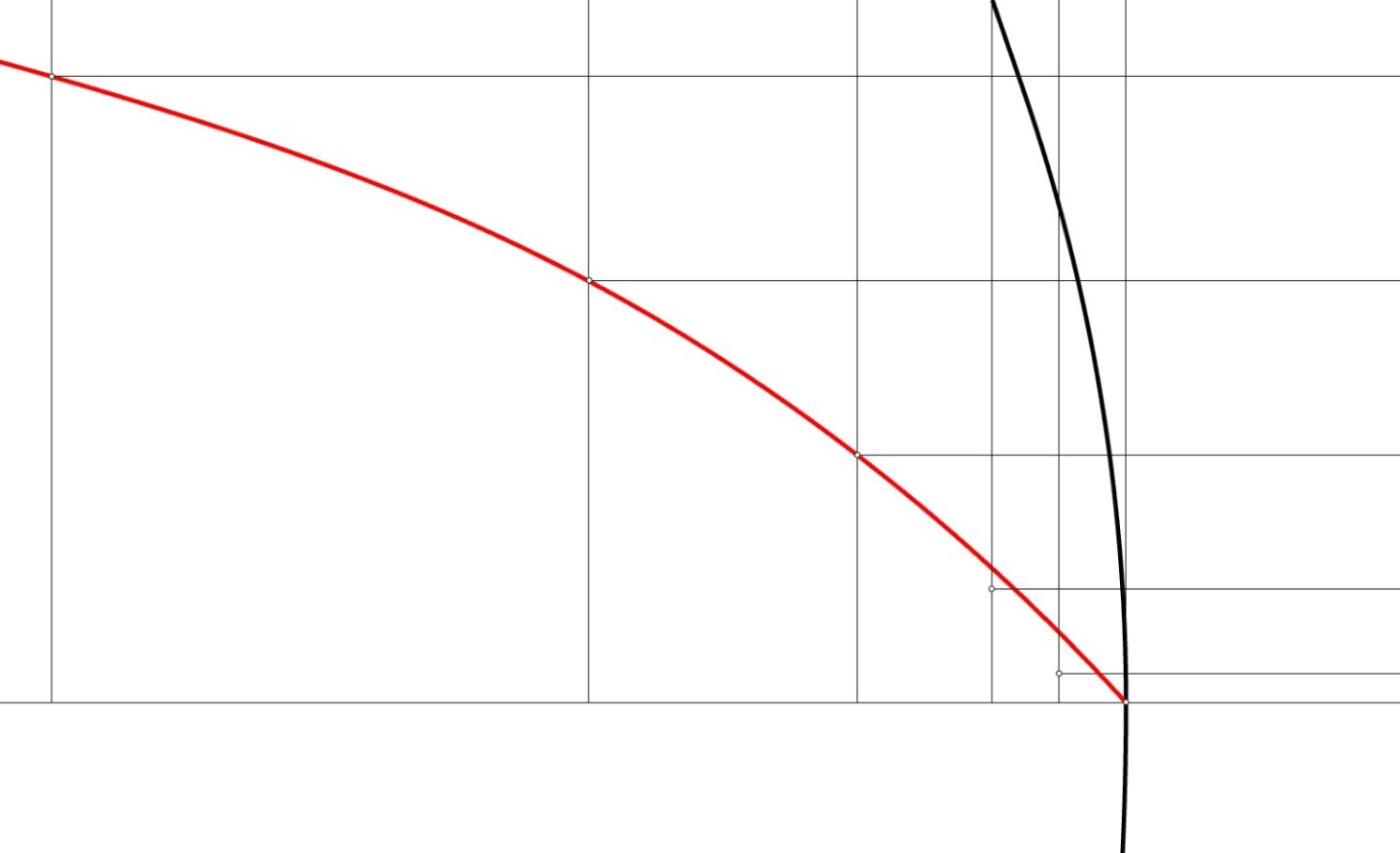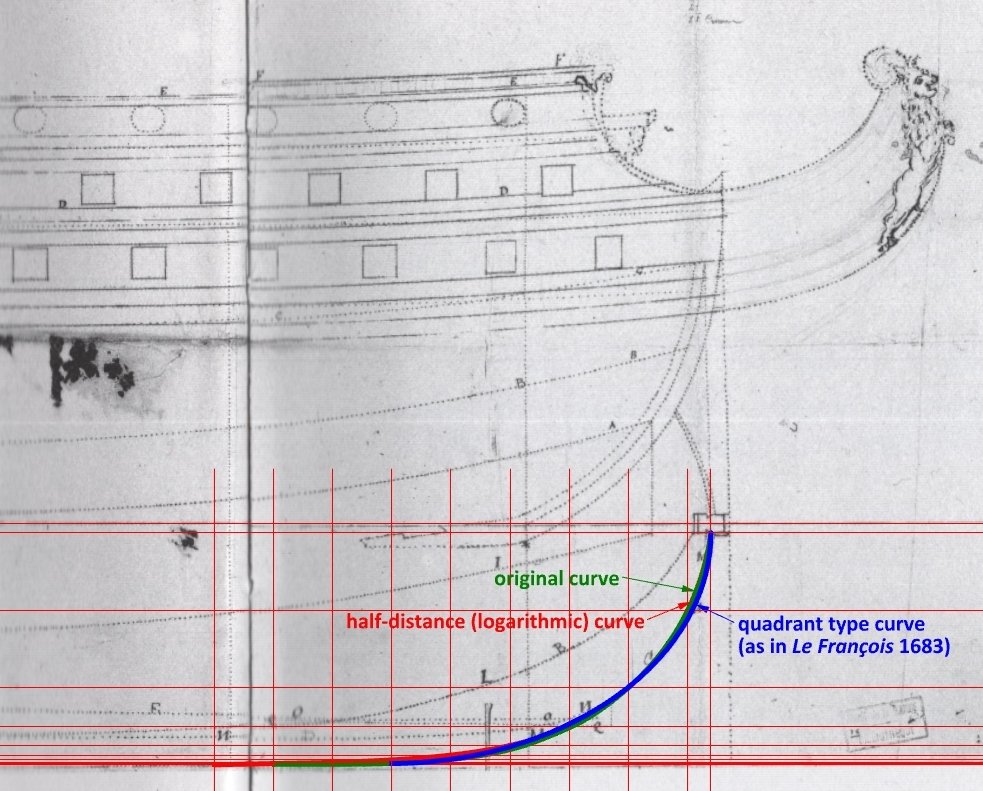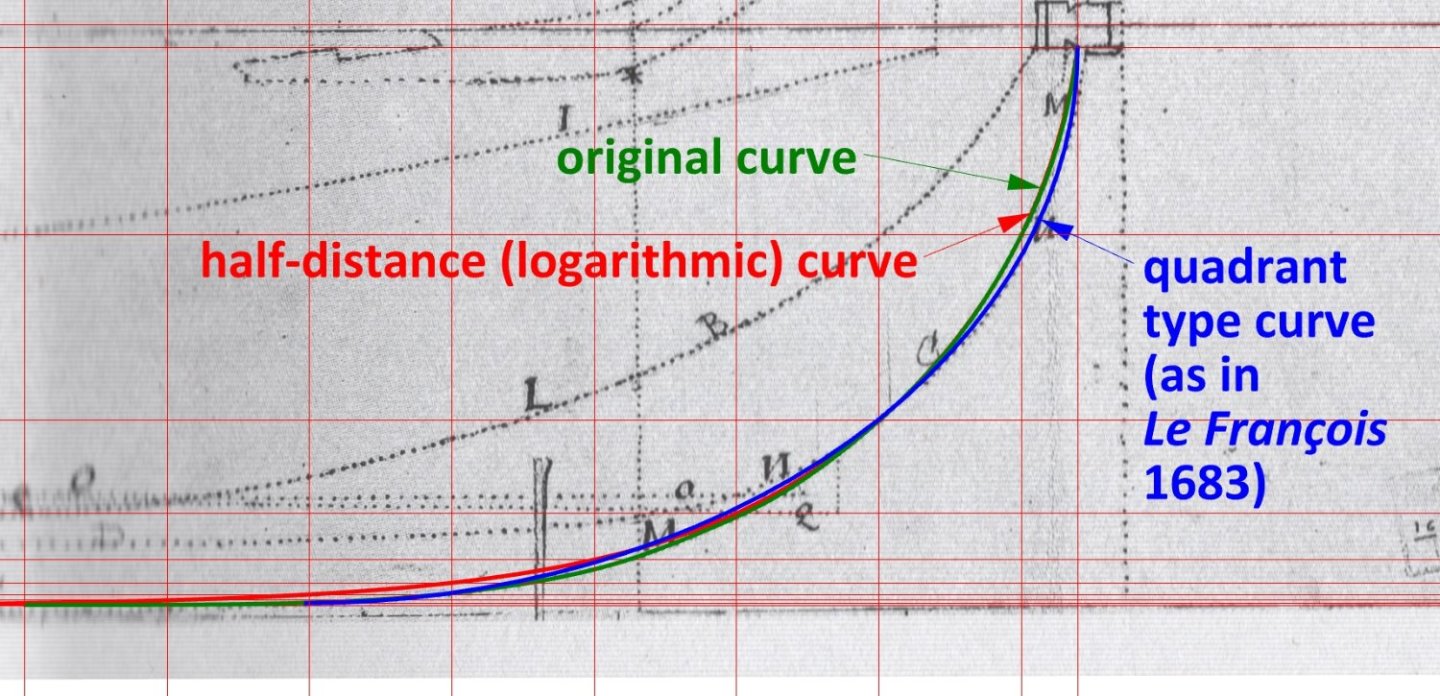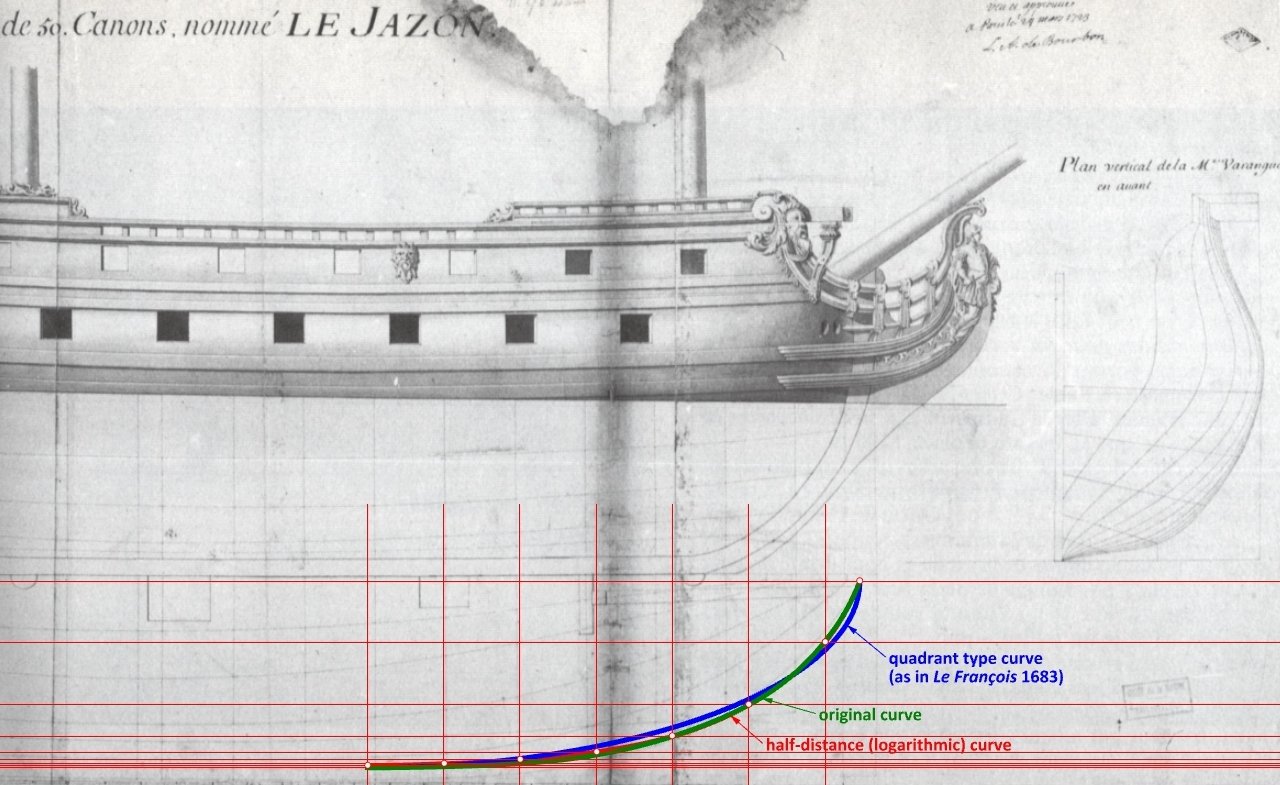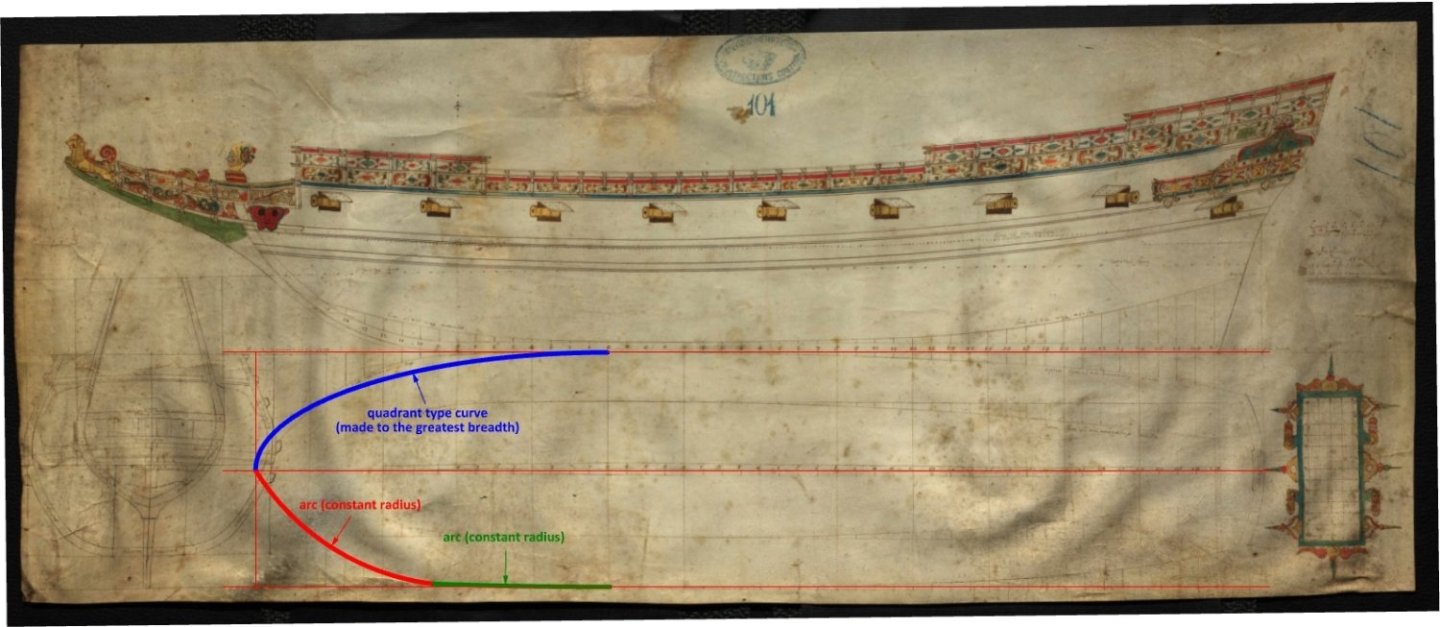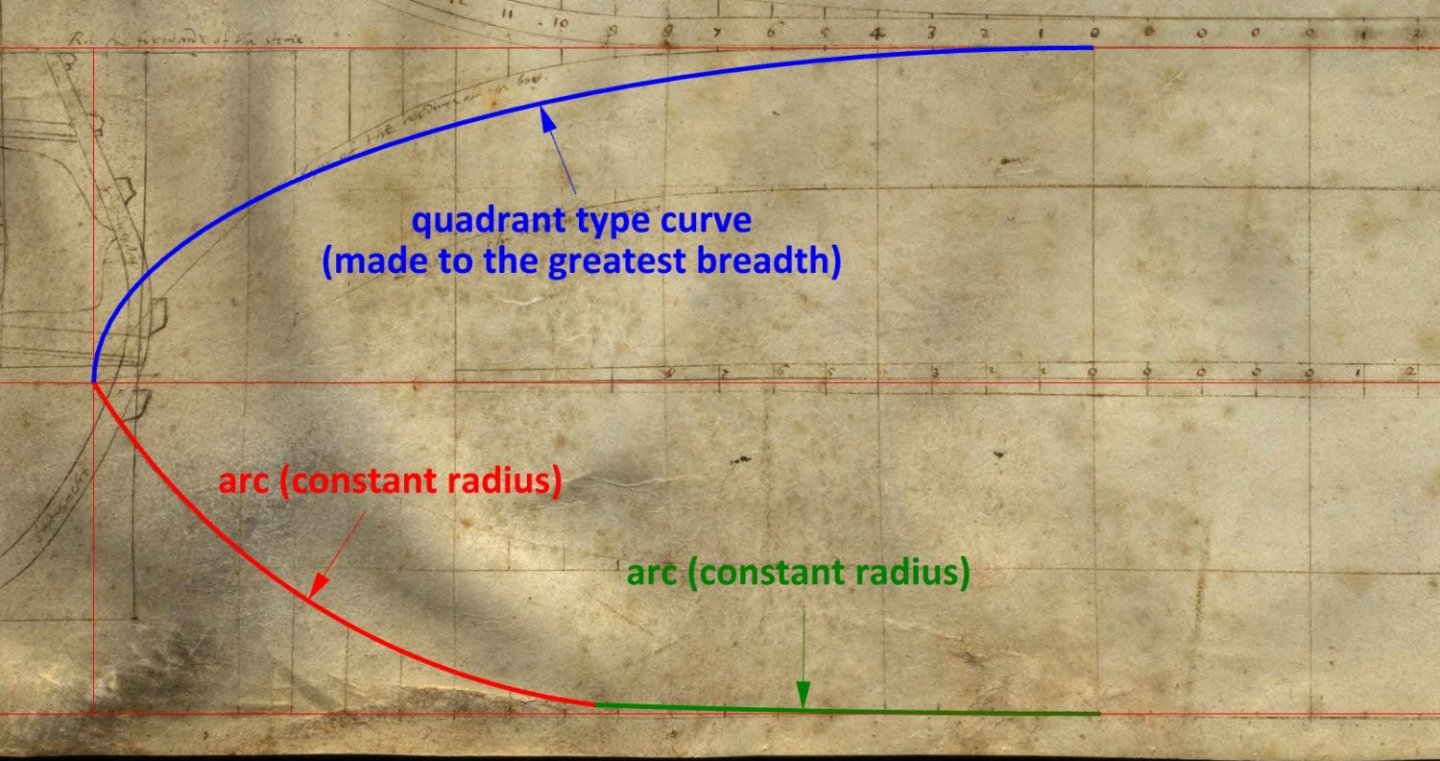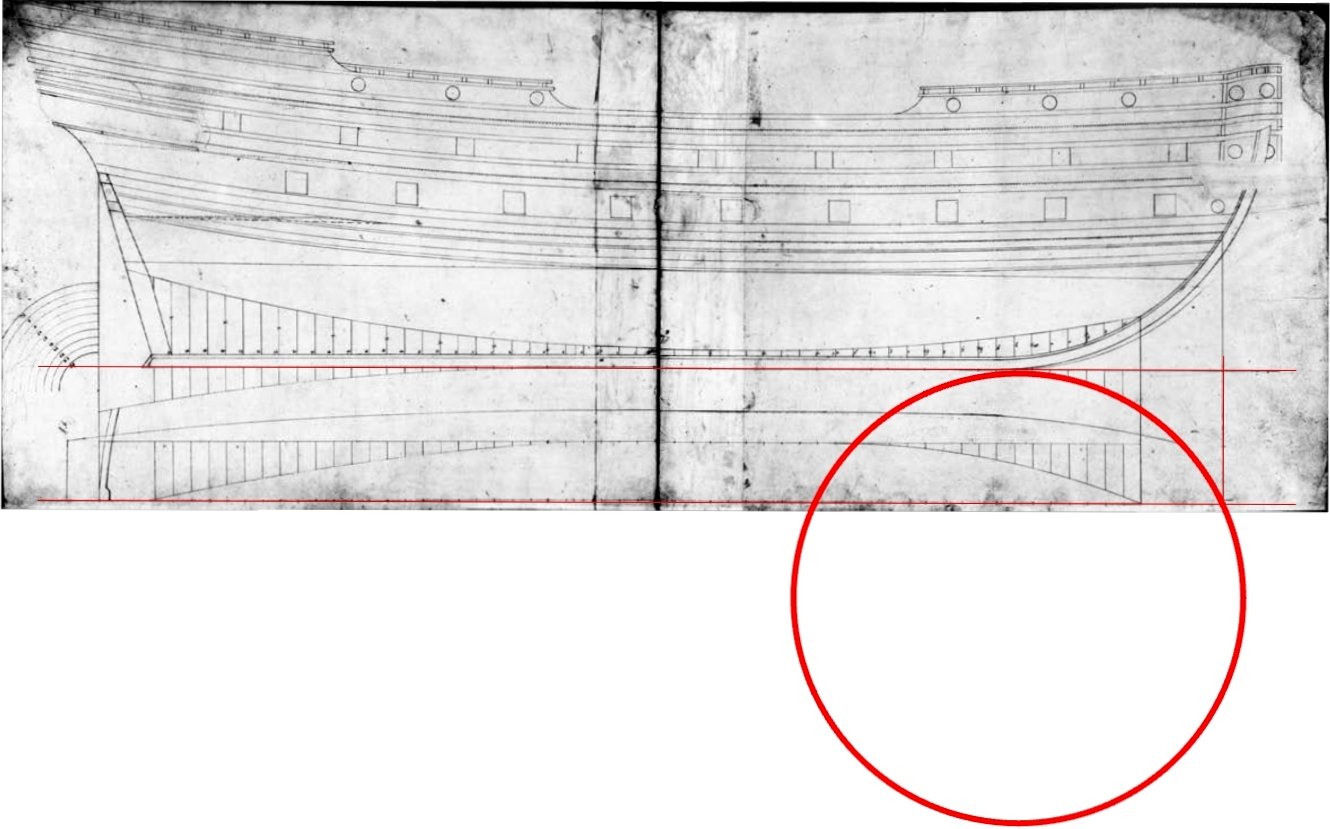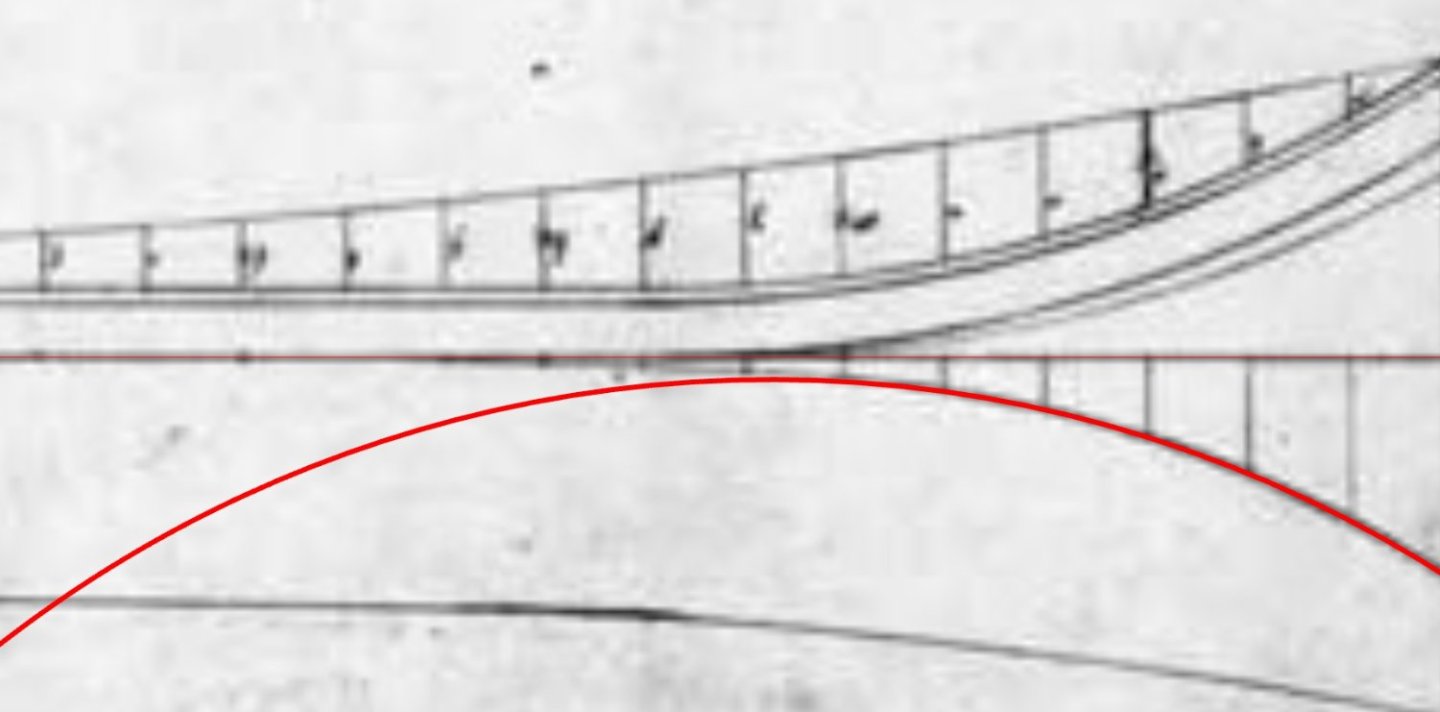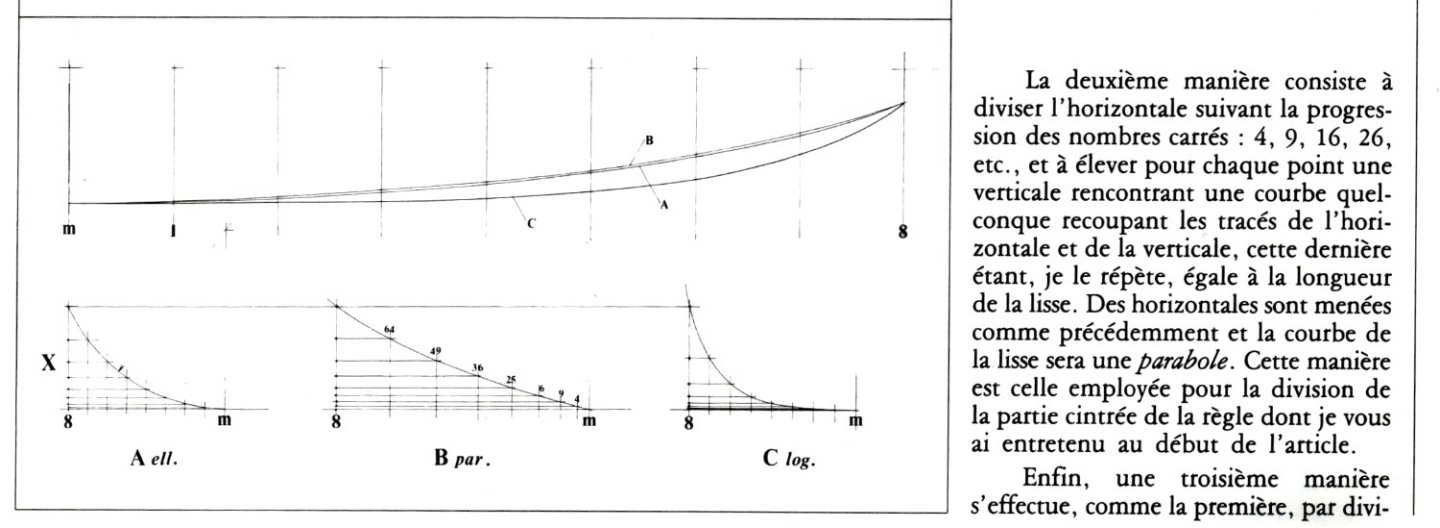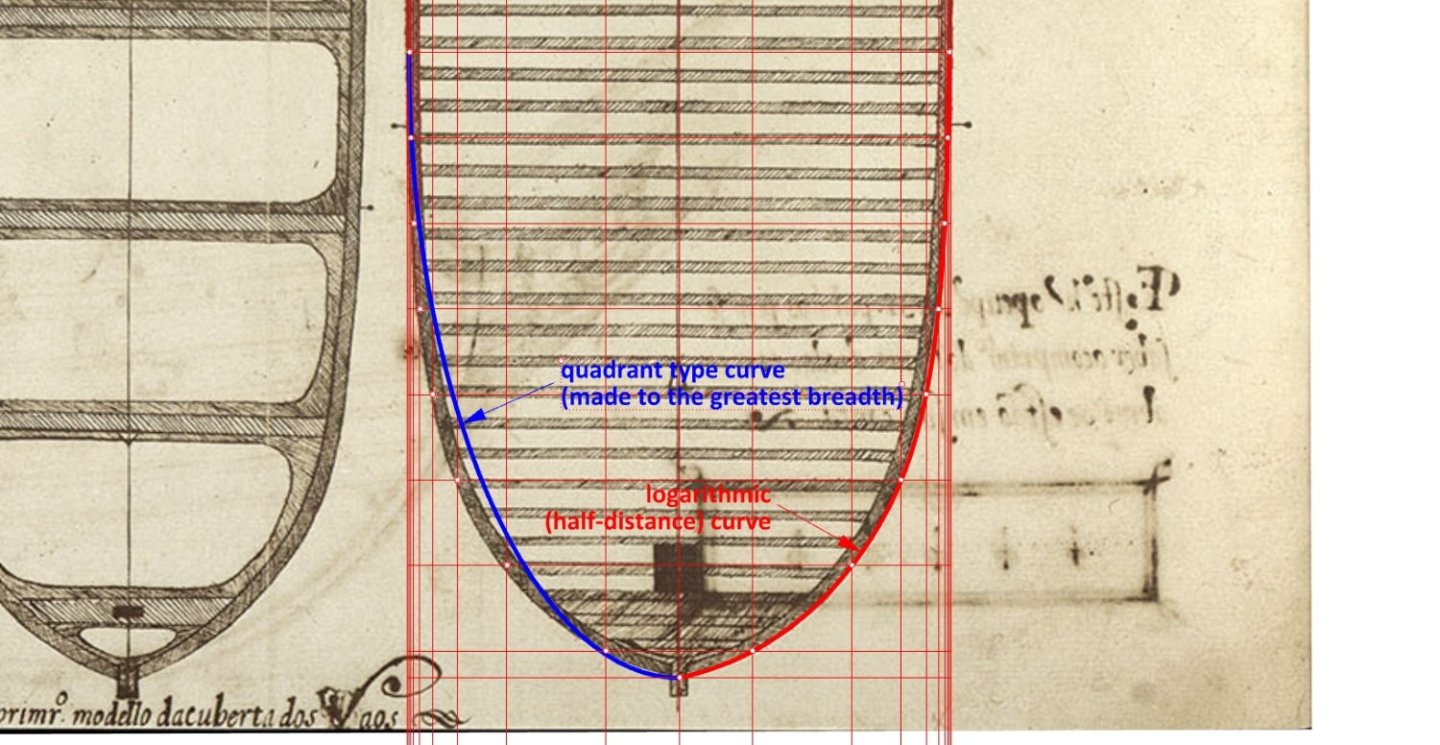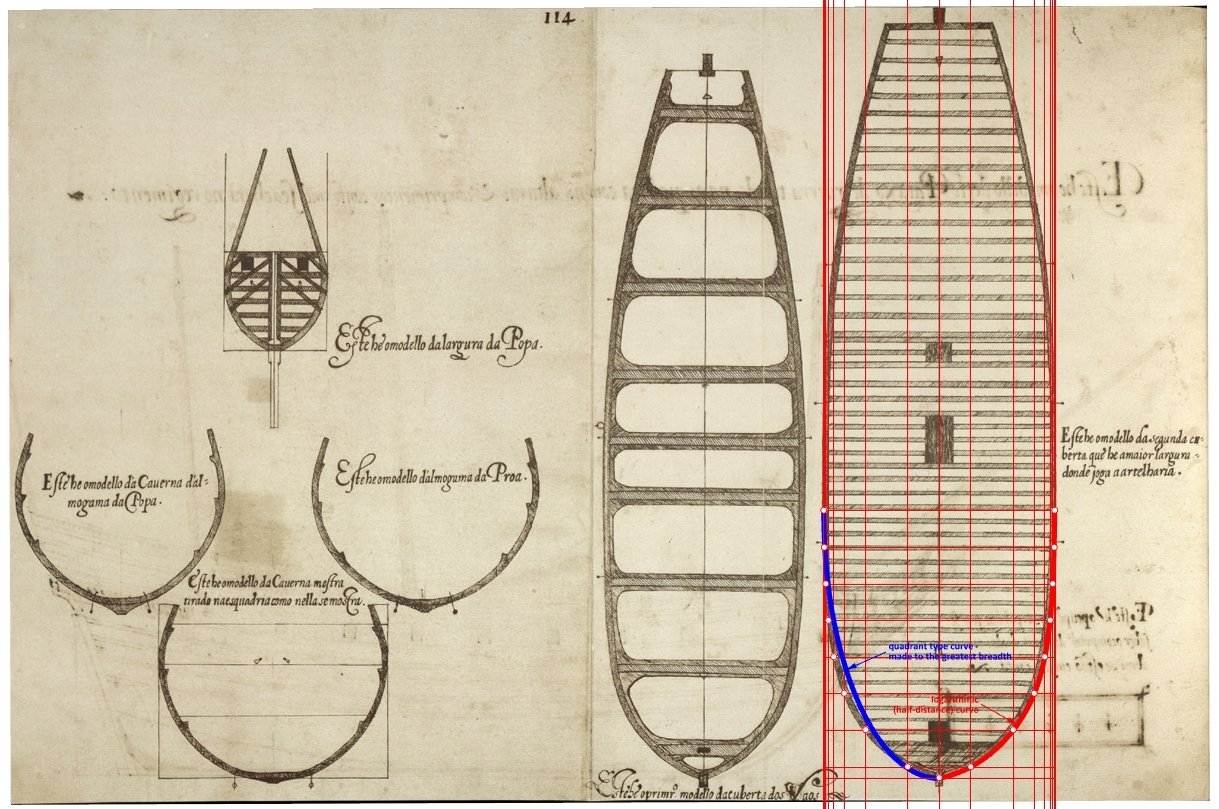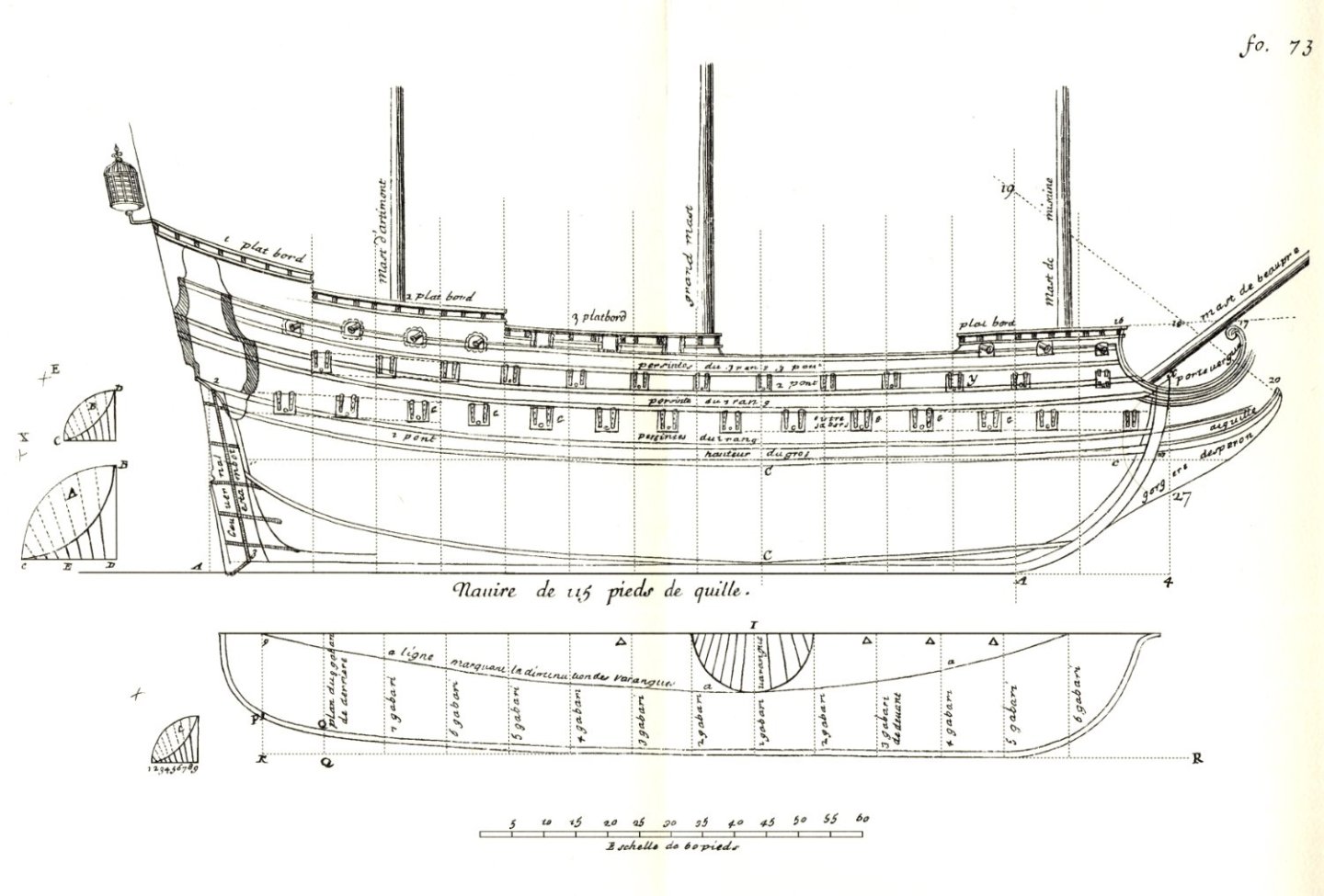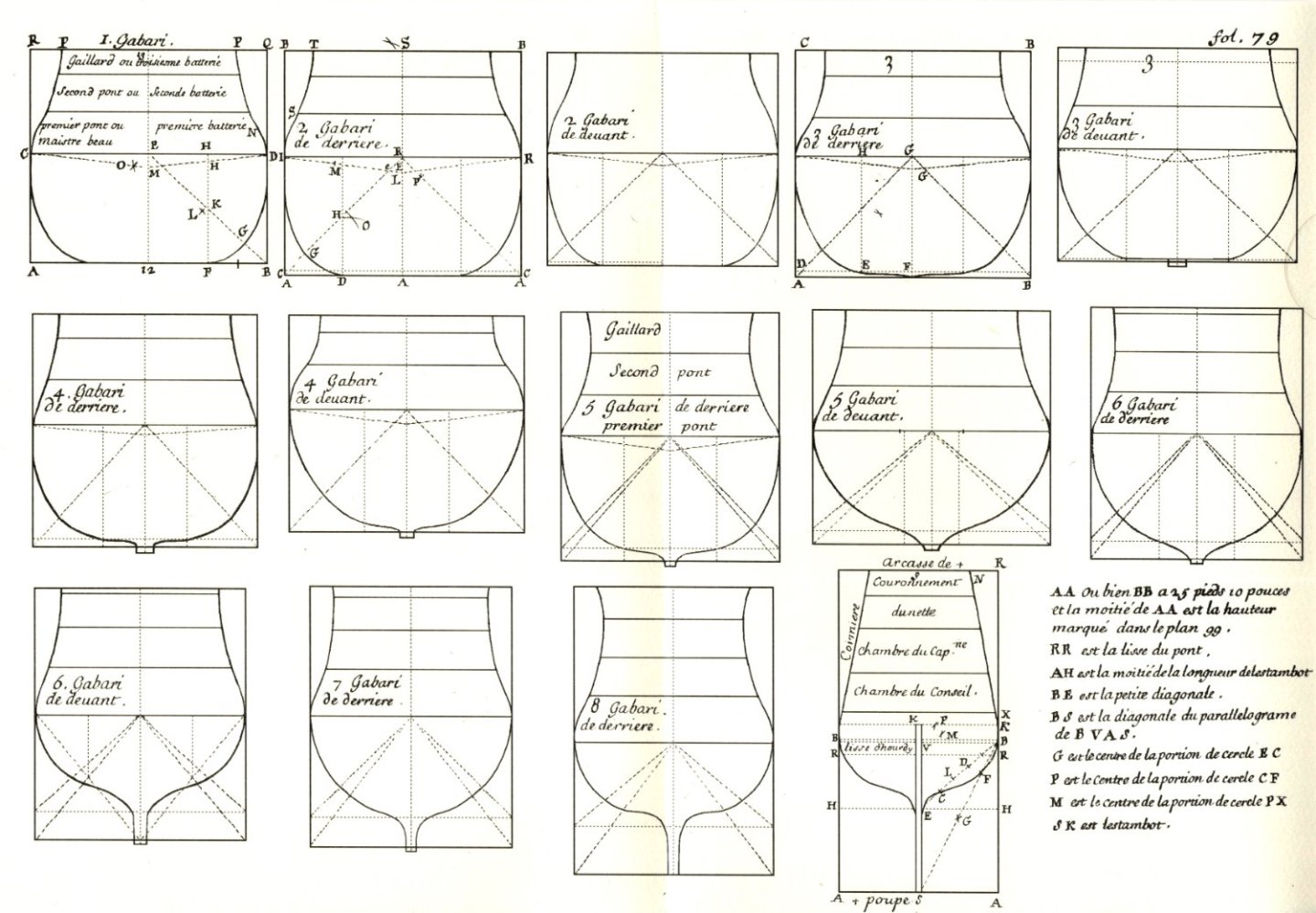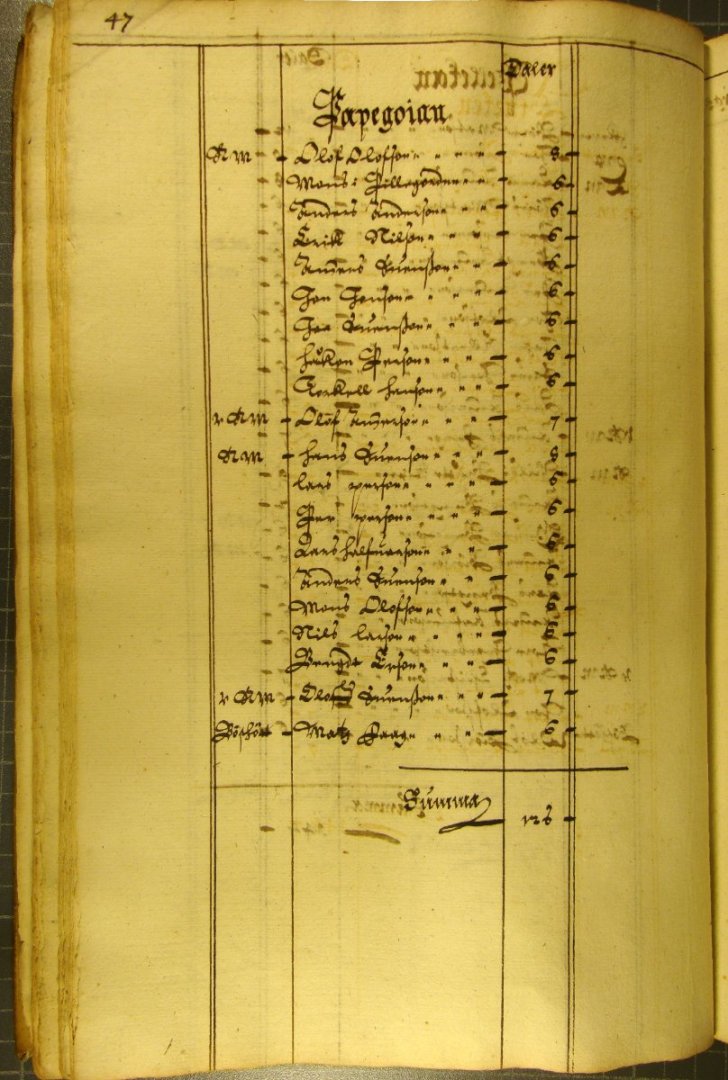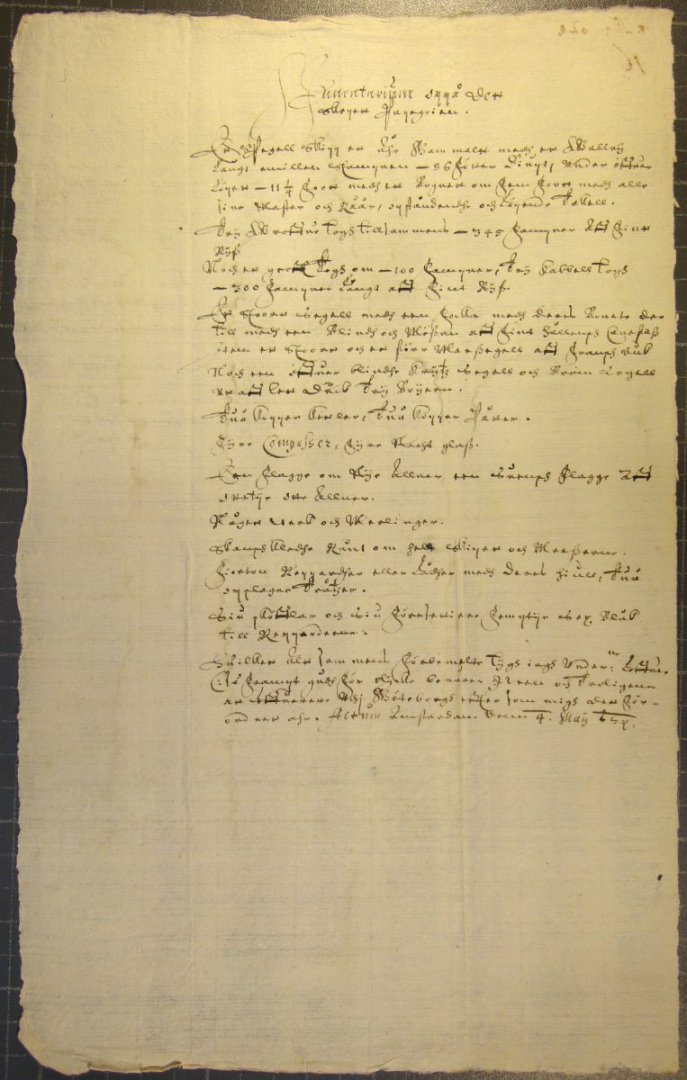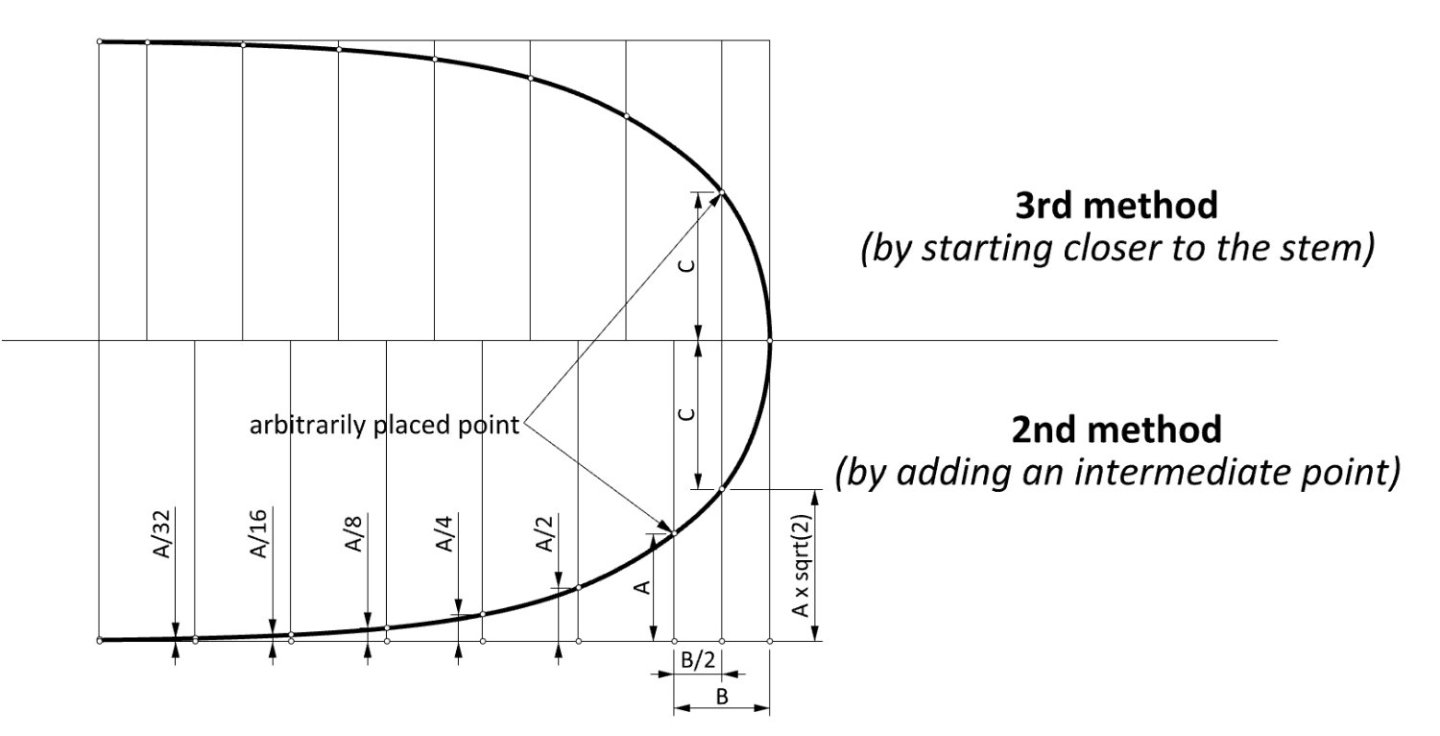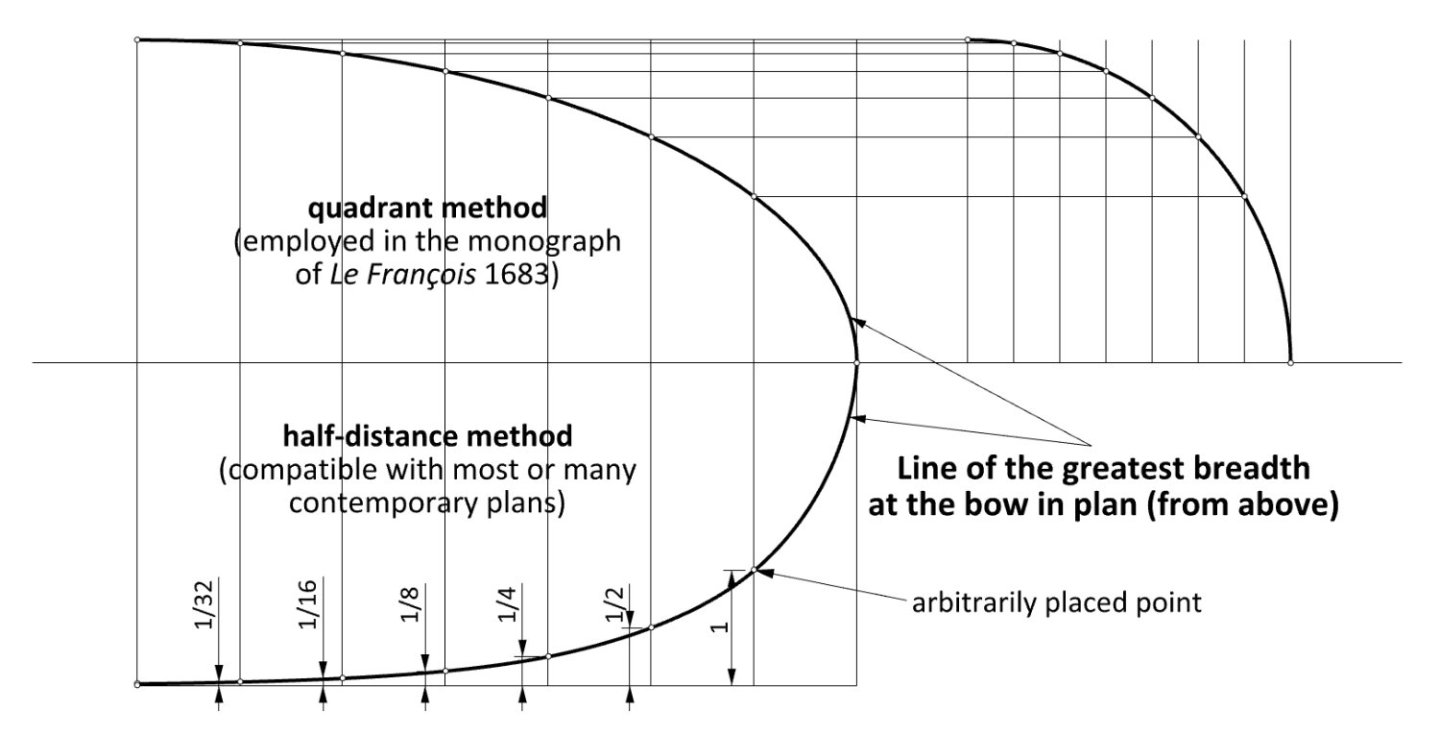-
Posts
986 -
Joined
Content Type
Profiles
Forums
Gallery
Events
Everything posted by Waldemar
-
.thumb.jpg.c6343966b029e7941df5b987d129aac6.jpg)
Bow shape of Le François 1683 and La Néréïde 1722
Waldemar replied to Waldemar's topic in Nautical/Naval History
Exactly! Depending on the shape wanted. Below is a diagram based on Dassié's description. He takes as an example a ship with a keel length of 115 feet (suitable for a third-rate ship of the line). Unfortunately, this is probably the weaker part of his work, as the formulas he gives cannot be taken completely literally, and the lines have to be corrected to get decent contours. As you can see, the line of the breadth obtained by his method has a kink at the main frame, and its forward course is already completely unacceptable (in red, I have added by eye a bow curve with a somewhat better course). As a result, despite the plausible concrete dimensions, the ways he gives should rather be perceived in a demonstrative manner. And just to clarify that the same defining lines (horizontal) are used equally for the bow and stern sections. -
.thumb.jpg.c6343966b029e7941df5b987d129aac6.jpg)
Bow shape of Le François 1683 and La Néréïde 1722
Waldemar replied to Waldemar's topic in Nautical/Naval History
For the sake of completeness, I've also included below a diagram showing the concept of forming ship hulls using mathematical formulas, as described in an anonymous English manuscript from around 1620. Mathematical methods were considered superior to graphical ones because of their greater precision. However, getting the bow curve of the desired shape was too challenging for these mathematical methods, and this very line still had to be corrected manually using the method shown in the diagram (also following the advice in this manuscript). ... on Dassié's way of shaping the bow curve in a while... -
.thumb.jpg.c6343966b029e7941df5b987d129aac6.jpg)
Bow shape of Le François 1683 and La Néréïde 1722
Waldemar replied to Waldemar's topic in Nautical/Naval History
Hubac's Historian: I have just reread the description of the ship's hull shaping given in Dassié's work (most of it). In fact, I was previously too harsh on his description. If you are going to buy this book, expect something very similar in most respects to Anthony Deane's work on naval architecture. Apart from that, you will find a lot more information about scantlings, masting, rigging, nomenclature, even on galleys, and the texts of the applicable Royal Ordinances. You should be much satisfied. What I didn't like about this book was the strange, rather convoluted formulas for the proportions of various ship elements, much more so than in other works. P.S. How to properly quote a user's name in the posts? -
.thumb.jpg.c6343966b029e7941df5b987d129aac6.jpg)
Redoing Oseberg
Waldemar replied to KrisWood's topic in CAD and 3D Modelling/Drafting Plans with Software
Yep, for CAD work only Rhino and I like it very much. Of course, my renders were only to show the idea of the proceedings, you choose the exact shape. -
.thumb.jpg.c6343966b029e7941df5b987d129aac6.jpg)
Redoing Oseberg
Waldemar replied to KrisWood's topic in CAD and 3D Modelling/Drafting Plans with Software
Or, when exporting pages from a PDF document as bitmaps, set higher resolutions. -
.thumb.jpg.c6343966b029e7941df5b987d129aac6.jpg)
Redoing Oseberg
Waldemar replied to KrisWood's topic in CAD and 3D Modelling/Drafting Plans with Software
The size of the inserted bitmaps into the posts is reduced (probably to a maximum of 1440 pixels of the longer side). Yes, these are quite nasty shapes to model, but possible. Try it this way, but your initial polysurface needs to be closed (for better clarity and less working time a straight element in this sample): This is not the only way, but probably the most convenient. -
Fantastico. La disposizione dei telai nel suo modello è quasi identica alla mia ricostruzione, con l'unica importante differenza che nel suo modello le singole costole sono costruite come un unico pezzo dalla chiglia fino all'estremità superiore, mentre nella mia ricostruzione i legni superiori sono "galleggianti" liberi. Mi riferisco a una nave dell'inizio del XVII secolo. Fantastic. The arrangement of the frames in your model is almost identical to my reconstruction with the only important difference that in your model the individual ribs are built as one piece from the keel up to the very top, while in my reconstruction the upper timbers are 'floating' free. I mean a ship from the beginning of the 17th century.
-
.thumb.jpg.c6343966b029e7941df5b987d129aac6.jpg)
Bow shape of Le François 1683 and La Néréïde 1722
Waldemar replied to Waldemar's topic in Nautical/Naval History
This is why I did not recognise this phenomenon earlier, reconstructing my ship straight away with a large number of stations, as in the example below. -
.thumb.jpg.c6343966b029e7941df5b987d129aac6.jpg)
Bow shape of Le François 1683 and La Néréïde 1722
Waldemar replied to Waldemar's topic in Nautical/Naval History
Thanks, Druxey. I was already starting to think it was only for geometry freaks. 🙂 I would also like to add that the problem of correcting the logarithmic curve at the back does not actually occur with a large number of stations, say, equal to the number of frames. Correction only becomes a necessity with a relatively small number of stations, such as on these French plans. However, in the former case, a factor of 0.5 may not be appropriate, and then it needs to be changed to another number. -
.thumb.jpg.c6343966b029e7941df5b987d129aac6.jpg)
Bow shape of Le François 1683 and La Néréïde 1722
Waldemar replied to Waldemar's topic in Nautical/Naval History
Originally, I just wanted to give a final visual demonstration of the concept of the non-graphical method of ship design using the bow curve as an example, but in doing so I probably discovered why, on the French example plans I posted earlier, the logarithmic curves are perfectly aligned with the original bow curves at the front, but do not quite coincide with them at the back. Below is a diagram showing a possible way of tracing the points of the bow curve. The tracing is done immediately to true scale on a tracing platform or other flat surface in the yard. Actually, drawing this bow curve is not needed at all in this non-graphical method, only the points are needed to get the outline of the frames in the next step, and for better clarity there are only five of them in the diagram. In the below magnification, you can see that some of the points obtained need to be moved slightly to get a bow curve with a nice contour on the front view. This would explain very well the need for such manual correction by ship designers. Why bother with it at all? And yet, along with archaeological finds and general iconography, this is the key to plausible reconstructions of ships from the period of non-graphic shipbuilding methods, or simply where original line plans have not survived. -
🙂 By 1625 part of the Swedish fleet was at peace footing, so crew shortages were not a problem and even an advantage (money!), until mobilisation in 1626 for a massive sea-borne invasion of the southern Baltic coast. I have found these documents, some 12-13 years ago, while looking for information on the Solen, the Swedish ship originally in the same group with the Papegojan, based in Götheborg. Just went to archives in Stockholm (Krigsarkivet and Riksarkivet), and bingo! Unknown and previously unpublished material. 🙂
-
.thumb.jpg.c6343966b029e7941df5b987d129aac6.jpg)
Bow shape of Le François 1683 and La Néréïde 1722
Waldemar replied to Waldemar's topic in Nautical/Naval History
Yes, indeed, here are my current views on these tools: Naturally, a great many curves were certainly drawn with flexible chord- or screw-tensioned battens. These are the near-perfect equivalents of today's CAD command: "draw curve through points" – almost indispensable but secondary tools in essence, because useless without predefined points. The use of these drawing aids is not even specifically mentioned in the source works on shipbuilding, in stark contrast to the extensive descriptions of determining the points that define the course of curves, be it by geometrical or mathematical means. To put it another way, these drawing aids were unlikely to have been used independently, i.e. to determine the entire course of the hull curves by eye only. Assuming that these aids always/usually produced smooth curves, they may have been used in the Portuguese and French examples, but not in the 'British' ones because of the scarcely visible details of these curves in the posted scans. In the first, English example, the curve has kinks, non-tangent points and sections of varying curvature. On the Argo plan, most of the bow curve is a perfect arc and only the last part of the curve is straighter. It is clear that in both of these cases the curves were drawn in two or more stages, as they could not have been created with a single tool giving smooth contours. Alternatively, the drawing aids actually used had some defects. But the most important thing from my perspective is that I was looking for a type of curve suitable for use in non-graphical methods of shaping ship hulls, rather than specific tools for drawing curves in graphical methods. -
.thumb.jpg.c6343966b029e7941df5b987d129aac6.jpg)
Bow shape of Le François 1683 and La Néréïde 1722
Waldemar replied to Waldemar's topic in Nautical/Naval History
All this does not mean that quadrant curves could not be used for the bow section at all. They could, and even quite successfully, but only on condition that the bows were very blunt, and the greatest width of the hull was very close to the stem. In practice, for large capital ships and merchantmen. And probably rather by less experienced draughtsmen. Below is an example of such a form of French origin from the late 17th century (from the monograph by Jean Boudriot, Le vaisseaux trois-ponts du chevalier de Tourville 1680) with curves of both types drawn in it. For self-assessment... (it is important to bear in mind that this plan is quite heavily distorted, and I have only made partial corrections). Rather the end, I've already done quite a lot of work on it anyway. -
.thumb.jpg.c6343966b029e7941df5b987d129aac6.jpg)
Bow shape of Le François 1683 and La Néréïde 1722
Waldemar replied to Waldemar's topic in Nautical/Naval History
Now we have finally arrived at the plans of Le Jazon 1724, which could probably best be used to recreate the shape of La Néréïde's hull. As can be seen below, the logarithmic curve only partly coincides with the original line, but it must also be added that the French designers were known for their so-called tâtonnement, i.e. modifying the lines manually in various ways. And even despite the lack of complete correspondence with the original curve, even the unmodified logarithmic curve still gives much better results than the quadrant curve. -
.thumb.jpg.c6343966b029e7941df5b987d129aac6.jpg)
Bow shape of Le François 1683 and La Néréïde 1722
Waldemar replied to Waldemar's topic in Nautical/Naval History
🙂 Thanks. Yeah, I had a meeting with these curves too in Sutherland's The Ship-builders Assistant, 1711. By the way, almost made the frames of my reconstructed ship with variable radius, as he proposes, but finally decided that the turn of the 16th and 17th centuries would be too early for such development. Before checking the French draughts I have also verified a few early plans of the 'British' origin and found their creators 'cheated' in a sense that they fabricated somewhat pragmatically this bow curve from two or more arcs, not necessarily perfectly tangent. Be that as it may, while this way of doing things was quite acceptable in graphic methods, it was entirely not practical in non-graphic methods, and I had to reject them. In this draught of the English origin of about 1625 (from the Rigsarkivet, Copenhagen), I have also drawn in blue a quadrant type curve. As can be seen, it is completely out of place. Below is a plan of the Danish ship Argo 1599 (Rigsarkivet, Copenhagen), designed by Scotsman David Balfour. -
.thumb.jpg.c6343966b029e7941df5b987d129aac6.jpg)
Bow shape of Le François 1683 and La Néréïde 1722
Waldemar replied to Waldemar's topic in Nautical/Naval History
This is not quite my intention to enter the dispute on this now. I will just stand by my opinion. But back to the curve of the greatest breadth at the bow. It is needed especially while trying to reconstruct the hull shape from scratch, and I started the search for a type of curve as employed by contemporary shipbuilders. Its geometrical construction had to be simple, easily adaptable to the non-graphical methods of hull shaping, had to connect the hull station at the ship's greatest breadth with the stem, and to provide a wide range of possible shapes, from very sharp to very full. In short, rather long search in period works for adequate type of such a curve failed, until help came from one of the excellent works on period naval architecture by Jean Boudriot – La conception des vaisseaux royaux sous l'Ancien Régime, Neptunia 169. The described method (shown at C above) of creating logarithmic curve seemed feasible, and after its adaptation for my purposes, already first comparisons with period ship plans gave desired results. The first to be checked were draughts made by professional shipbuilder from 'my' period, Portuguese Manuel Fernandes (from his Livro das Traças de Carpintaria, 1616). -
.thumb.jpg.c6343966b029e7941df5b987d129aac6.jpg)
Bow shape of Le François 1683 and La Néréïde 1722
Waldemar replied to Waldemar's topic in Nautical/Naval History
Preparing graphics takes time, please give me some of it. Yes, I have both works in my home library and that's why I haven't listed them above. The Album de Colbert has nothing to do with the concept of ship design, and Dassié's work is very poor in that respect. I have included scans of two plates regarding this issue from his book. There are quite a few oddities in his work and this one is also quite disappointing. I would rather never choose to try to recreate the hull shape basing on Dassié's description. -
.thumb.jpg.c6343966b029e7941df5b987d129aac6.jpg)
Bow shape of Le François 1683 and La Néréïde 1722
Waldemar replied to Waldemar's topic in Nautical/Naval History
Well, in most cases probably yes, depending on the method and assuming we mean early modern area. Simplifying a bit – there were then many methods of deriving hull shapes. They could be graphical or non-graphical (ie. no scale plans were necessary), the ships could be formed and built by shell methods, frame-led methods or skeleton methods. In these methods all, some or no actual frames were pre-designed (i.e. formed before their assembly in the hull structure). And all kind of intermediary ways... There was a very widespread method, in which main frame profile was offset and slightly rotated almost as one entity to get the shape of other frames. This way the rest of the frames could be formed on the shipyard ground before their insertion into the constructed hull. But this was only possible to some point, limited by those two 'quarter' frames. Beyond these 'quarter' frames the hull ends were then usually shaped by using flexible battens. In the early variants of the more flexible 'hauling up/down futtocks' method (in which the main frame shape was divided into several 'independent' geometrical parts) the 'quarter' frames were still being retained, but they were already not really necessary, as in this method pre-designed frames could be usually formed till the very ends of the hull. Those three crucial frames could be also employed in the frame-led method, and nothing more except flexible lengthwise battens. In a slightly later, already fully graphical methods employing geometrical 'battens', these two 'quarter' frames could be dispensed with at all. In the shell methods, these two 'quarter' frames could be equally superfluous. Yet, it is best to consult the sources. For the 16th and 17th centuries I would recommend the following works: – Fernando Oliveira, Livro da fabrica das naos, ca. 1570–1580 – English so-called „Newton” manuscript of ca. 1600 – Manuel Fernandes, Livro das Traças de Carpintaria, 1616 – English anon. manuscript of ca. 1620 – Spanish government ordonances (dimension establishments) of 1607, 1613 and 1618 – Georges Fournier, Hydrographie, 1643 – Bushnell Edmund, The Compleat Ship-Wright, 1664 – Anthony Deane, Naval Architecture, 1670 Alternatively, or additionally, the excellent modern works on the period naval architecture by such expert authors like Jean Boudriot, Éric Rieth, Richard Barker, Filipe Vieira de Castro, Alan Lemmers. -
Voilà, I sent you by PM copies of my publications on the Swedish ship division from Götheborg, which included Papegojan. But honestly, I don't think you'll get much practical use out of them either (although you'll find a lot of tables and graphics in them, especially on the Swedish artillery), because the information about Papegojan is also very scattered there, and they are written in Polish. However, these publications may be good just to enrich your private collection related to your model. If that is not enough, below are most data on Papegojan already filtered: 1623 built in the Netherlands and sold, 1624 transferred to Sweden, 1644 sunk in battle. Armament: 1625 (requirement, not actual!): 12 x 3-pdr iron long guns, 2 x 24-pdr bronze assault guns (Schrotstucke), 2 x 'mershakar' (a type of swivel gun), until May 1626 (actual): 4 x 6-pdr iron long guns, 6 x 3-pdr iron long guns, until autumn 1626 (actual): as above plus 4 x 3-pdr bronze long guns and 2 x 24-pdr bronze assault guns (Schrotstucke), 1627 (actual): 4 x 3-pdr bronze long guns (heavily under-armed due to service as supply ship in this campaign). I have ignored the following years as they were outside the scope of my study; see my first and fourth papers for the appearance of the Swedish guns and carriages. Crew: 1625 (requirement): 27 sailors, 5 gunners, May 1626 (actual): 20 sailors, 1 gunner (the ship was heavily undermanned due to general lack of manpower), 1628 (requirement and/or actual according to various documents): 48 sailors, 60/50/60/35 troops. Papegojan payroll of 20 sailors from May 1626 (Riksarkivet, Stockholm):
-
Yes, it's entirely possible, albeit somewhat unpractical. Firstly, most of the data on this ship is scattered in many documents concerning the entire fleet, and secondly, you may not have any use of them as they require extremely difficult transcription and translation. It would be more convenient for me to provide ready-made information that I have already derived of these documents and published more than ten years ago. As an example, I include a copy (both in low and high resolution as PDF) of a document dated 4 May 1624, just after the purchase of the ship and its delivery to Götheborg from Netherlands (Inventarium oppå det skeppet Papegoian, Riksarkivet, Stockholm). There you can read, among other things, that the Papegoian was simply referred to as a square-tuck/transom ship (spegell skipp, or in German Spiegelschiff), that it was then one year old, had one boat (referred to as a galley), length between posts of 86 feet, depth in hold of 11 1/4 feet, an upper deck (bognet, or in Dutch bovenet) 5 feet above the main deck, 14 gun carriages, sails: mainsail with bonnet, foresail with bonnet, spritsail, mizzen sail, main topsail, fore topsail, sprit topsail (blindhe krÿtz segell), (main) topgallant sail. And some other, supposedly less important information (like length of cables and ropes, size of flags etc.). So, if you need just the ready data, I can provide them quite fast, but if you need original documents, it will take much longer to locate and gather them from a set of hundreds of scans. Inventarium Papegoian 1624.pdf
-
.thumb.jpg.c6343966b029e7941df5b987d129aac6.jpg)
Bow shape of Le François 1683 and La Néréïde 1722
Waldemar replied to Waldemar's topic in Nautical/Naval History
Good question. Indeed, additional effort is sometimes necessary to get a decent curve. – 1st method: simply approximating by eye (sufficient in many cases and evidently used by period designers; allows a slight, deliberate modification of this curve at the stem area), – 2nd method: by defining an additional point on the middle line (better explained in the attached sketch), – 3rd method: by placing the first defining point closer to the stem (the rest of the procedure is the same). And, by the way, the factor can be other than 0.5, yet it is the most convenient number. -
The monography of the French frigate La Néréïde 1722 is now being in preparation by the author of many other fine monographs – Jean-Claude Lemineur, and of my utmost curiosity is the exact way the shape of La Néréïde's hull was reconstructed by him. It should be noted that the source plans do not include a line plan of the entire hull, only the profile of the main frame and the longitudinal shape of the vessel. In parallel with the creation of the monograph, an attractive model of the ship is being built by Michele. While it is not quite possible to assess well the hull lines directly from the photos of the model, I get the impression J.-C. Lemineur has taken a similar approach as in his reconstruction of Le François 1683, in which he employed the quadrant type curve for the bow shape. Yet, upon making my own reconstructions, I have discovered that such a curve, while looking good and being very useful for recreating many other parts of the hull, never works satisfactorily for the ships' bows. To put it the other way, it can never be aligned with the corresponding lines in any contemporary ship plans (notwithstanding the many possible modifications of this curve). In turn, the method of deriving this curve shown at the bottom of the attached sketch almost always gives the desired results. This half-distance derived curve can be also modified in many ways to get, say, sharper or blunter bows. Strangely, I have not found this method in any contemporary works on shipbuilding I have consulted, and it was reverse-engineered by trial-and-error.
-
Hello Roman, What a coincidence! You built a ship that took part in a battle in which the flagship was the ship I am currently reconstructing (Polish/German Sankt Georg). An account of this reconstruction can be found on this forum. It is probably too late for this now, as you have already built your model, but in the course of my historical research I also found in the archives in Stockholm quite a few source documents concerning the Papegojan. Amongst other things, these documents contain information on the ship's dimensions, number of sails, armament and crew numbers in the various years of the ship's service. I would follow the 'sea' trials of your Papegojan with the utmost interest.
About us
Modelshipworld - Advancing Ship Modeling through Research
SSL Secured
Your security is important for us so this Website is SSL-Secured
NRG Mailing Address
Nautical Research Guild
237 South Lincoln Street
Westmont IL, 60559-1917
Model Ship World ® and the MSW logo are Registered Trademarks, and belong to the Nautical Research Guild (United States Patent and Trademark Office: No. 6,929,264 & No. 6,929,274, registered Dec. 20, 2022)
Helpful Links
About the NRG
If you enjoy building ship models that are historically accurate as well as beautiful, then The Nautical Research Guild (NRG) is just right for you.
The Guild is a non-profit educational organization whose mission is to “Advance Ship Modeling Through Research”. We provide support to our members in their efforts to raise the quality of their model ships.
The Nautical Research Guild has published our world-renowned quarterly magazine, The Nautical Research Journal, since 1955. The pages of the Journal are full of articles by accomplished ship modelers who show you how they create those exquisite details on their models, and by maritime historians who show you the correct details to build. The Journal is available in both print and digital editions. Go to the NRG web site (www.thenrg.org) to download a complimentary digital copy of the Journal. The NRG also publishes plan sets, books and compilations of back issues of the Journal and the former Ships in Scale and Model Ship Builder magazines.




